Last-Minute NYC Holiday Gift Guide 🎁
We’ve created a holiday gift guide with presents for the intrepid New Yorker that should arrive just in time—


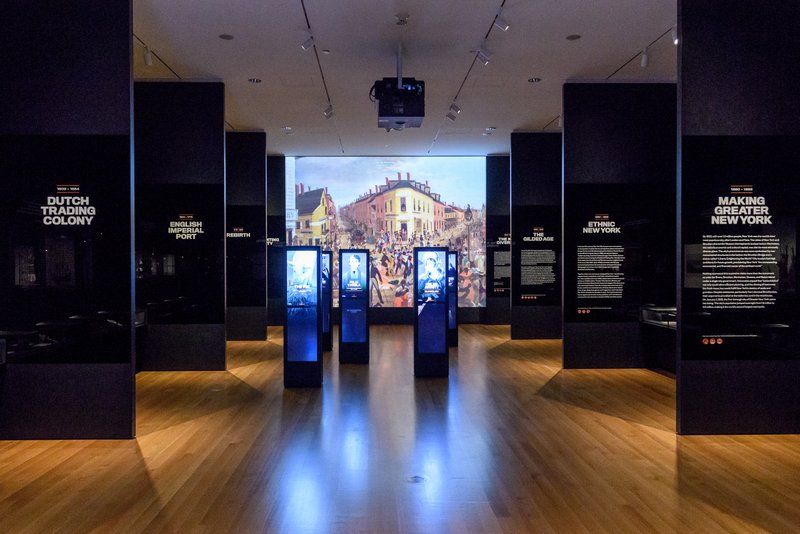 Inside Port City, 1609-1898. Photo by Filip Wolak courtesy MCNY
Inside Port City, 1609-1898. Photo by Filip Wolak courtesy MCNY
New York At its Core at the Museum of the City of New York is a landmark exhibit covering 400 years of New York City history. Even though the entire first floor of the museum is dedicated to this new permanent exhibition, four hundred years of history necessarily requires a Herculanean task of curating and editing. As Sarah Henry, Deputy Director and Chief Curator at the Museum of the City of New York, explained to us as we walked through the exhibit just before the opening in October, “We are not trying to do an encyclopedia here. We are trying to give people a framework in which to think about what makes New York, New York.” And the items are included to illustrate that framework are carefully chosen.
Here, we pick out ten things to keep your eye out for in New York At its Core as you walk through New York City’s past, present and future.
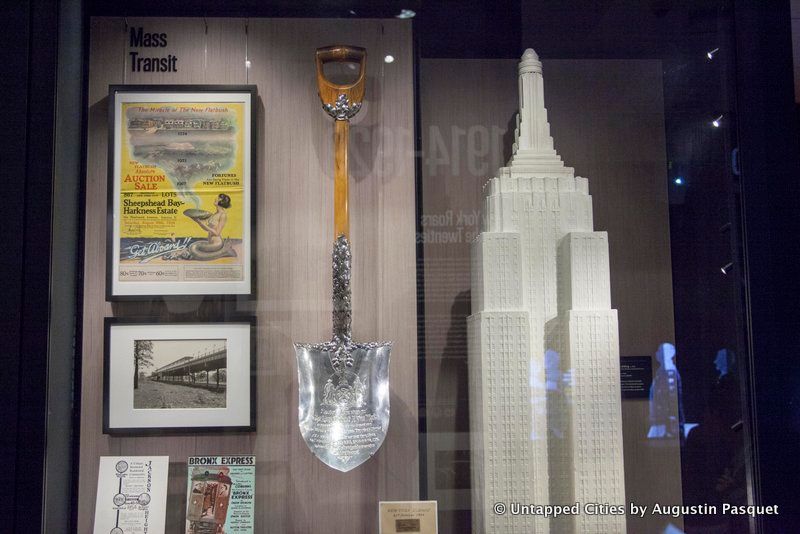
The second gallery, World City, covers a time period that includes the opening of the first New York City subway line. On display is a ceremonial Tiffany & Co. silver shovel from 1900, used by Mayor Robert Van Wyck to break ground on the IRT subway line, which would open in 1904. The wood is made from a tree planted by Alexander Hamilton in 1803 and from a ship that fought in the War of 1812. The shovel is in the collection of the Museum of the City of New York, a gift of Mrs. William Van Wyck. Also in this case is one of the first subway tickets for the new line.

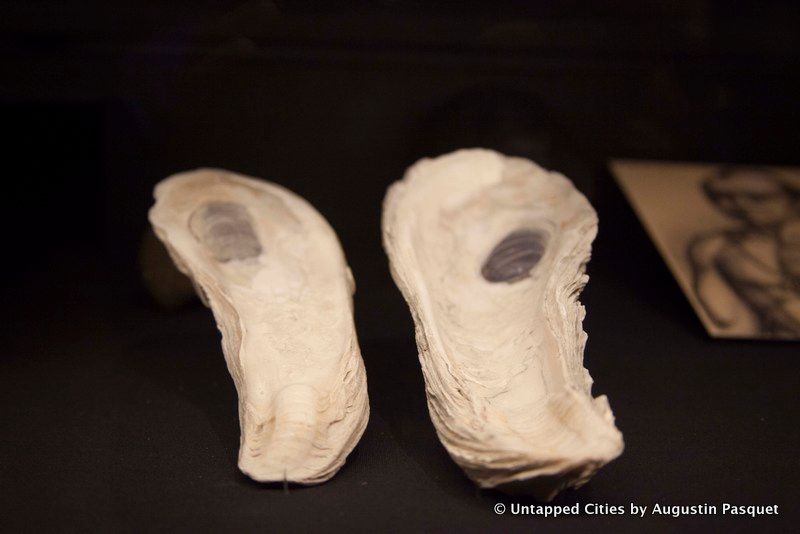
The tragic history of New York City’s oysters (and its recent renaissance) tells the story of New York City’s waterfront and much about its early settlers. A first person account by a Dutch missionary named Jasper Danckaerts, recounted in the book Gowanus: Brooklyn’s Curious Canal, describes Gowanus oysters in 1679 as “large and full, some of them not less than a foot long, and they grow sometimes ten, twelve and sixteen together, and are then like a piece of rock.”
Readers have asked us before whether there is actual evidence of oysters “the size of dinner plates” or a “foot long. While the oyster shells in the Port City gallery of the exhibition, on loan through the New York State Museum in Albany, may not be dinner plate shaped, the larger one is close to a foot long. Its inclusion highlights how the Lenape Indians who first settled the island that is now Manhattan “used the natural resources of the Hudson River estuary in many ways. The plentiful oysters and clams were not just food: their shells could be turned into tools and ornaments,” describes the exhibition display. Sadly, though the Lenape were careful to keep their lifestyle sustainable, their population was reduced drastically through disease, warfare and migration. By 1700, only small groups remained, scattered across the five boroughs.
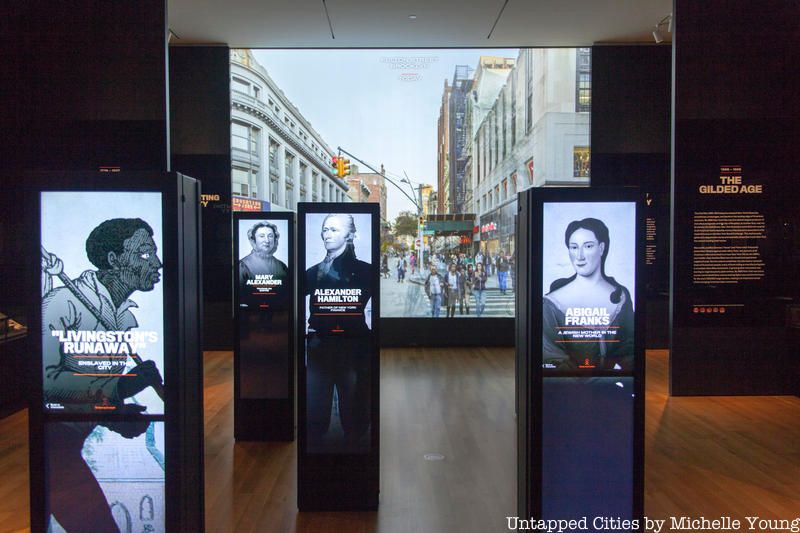
On the back wall of the Port City gallery, seven scenes dissolve from past to present. For example, a vision of Flushing in the days of Mannahatta becomes a photograph by Jeff Chien-Hsing Liao from today, with Citi Field and the new developments under way. Liao had his own exhibit, Assembled Realities, at the museum in 2014. Positioned on the floor in front are five interactive terminals, designed and programmed by the studio Local Projects, which also did the rest of the interactive displays in the exhibit. With each new image on the back wall, the floor units show new sets of characters who lived in New York City at that time that you can use the touch screen to learn more about.

An original Russ apple peeler is on display in the second gallery, World City, and was the star of the first trailer for the exhibition over the summer. It was used predominantly to peel Granny Smith apples used in the chopped herring salad, an item still available at Russ & Daughters today. It was a classic melding of old and new traditions adapting basic immigrant food taste to what was available in the New World.
The peeler is a “poetic encapsulation of the story of New York City,” says Sarah Henry, Deputy Director and Chief Curator at the Museum of the City of New York. It helps tell the larger story about New York City’s immigrant culture, explains Henry: “If we want to understand how the city has changed, understanding those new arrivals is the key to that.”

The dapper field drafting set owned by Calvert Vaux, the architect who co-designed Central Park with Frederick Law Olmstead, is on display in the Port City gallery. The case is leather, with the words CALVERT VAUX NEW YORK embossed in gold. Inside, it contains a pencil, a wooden burnisher, and a drawing compass.
While Olmstead may have become the more household name in the last century, it was Vaux who actually persuaded Olmstead to work on Central Park with him. The success of the park led to the creation of a company together, in which they would produce the design for Prospect Park, Morningide Park, and Fort Greene Park. Vaux was prolific in his career, designing the American Museum of Natural History, the Jefferson Market Courthouse, part of the Metropolitan Museum of Art, the mansion of governor Samuel J. Tilden (now the National Arts Club on Gramercy Park). He also worked on design of the Soldiers’ and Sailors’ Arch at Grand Army Plaza in Brooklyn with Olmstead and Stanford White.
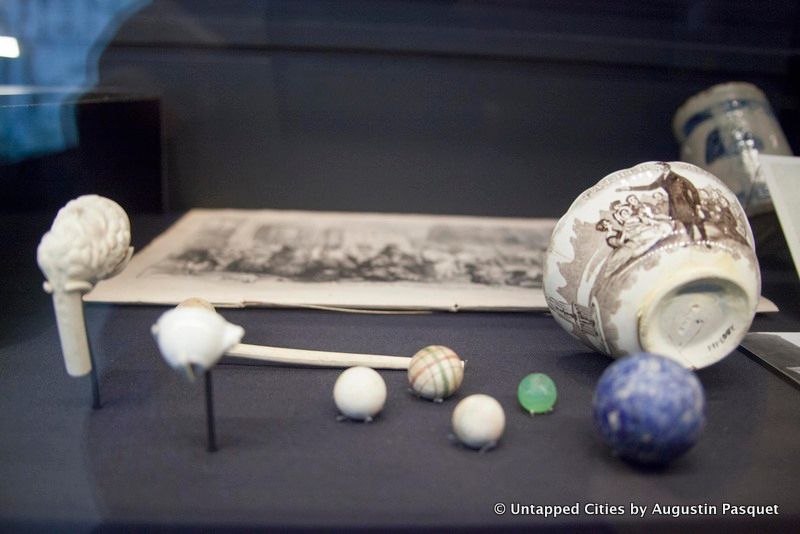
In 1990-91, thousands of artifacts from the Five Points neighborhood were discovered in a dig. Except for seventeen pieces, the collection was destroyed on September 11, 2001 in the World Trade Center where they were stored. These lucky items happened to be in circulation at that time. Among the items on display are clay smoking pipes, a whiteware teacup, a miniature porcelain teacup, and glass marbles that date to 1820-40. These items are in the collection of the Museum of the City of New York, a gift from the U.S. General Services Administration. In the second gallery, World City, an artifact from 9/11 – a twisted World Trade Center sign – is on display.

Robert Moses had his own version of a Vaux drafting kit, but used it to carry and showcase his badges. Here are his badges as the Chairman of the Triborough Bridge Authority and Commissioner of the Department of Parks. As BLDZR, the recent musical about Robert Moses and Jane Jacobs so well explains, Moses was an unelected official, but presided over New York City for 45 years. His tenure as head of numerous commissions, most notably the Triborough Bridge Authority, lasted through six governors and five mayors.
New York At its Core sums it up succinctly: “Moses used his multiple positions to funnel money into city projects,” and what’s important to remember is that much of that money was federal, given to New York City thanks to a close partnership between Mayor Fiorello LaGuardia and President Franklin D. Roosevelt. “By augmenting Moses’ power over public money and construction,” the display reads, “the New Deal also clinched his role as New York’s ‘master builder,’ whose massive, often controversial projects would radically transform New York.”
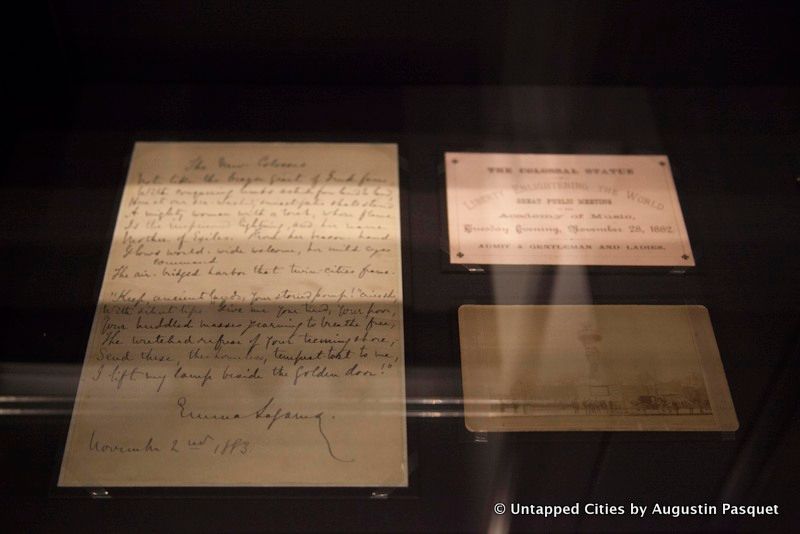
One display case in Port City is dedicated to the construction of the Statue of Liberty and includes an original manuscript from Emma Lazarus of “The New Colossus,” from which the famous lines inscribed on the statue’s bronze tablet come from. The sonnet includes the famous phrase, “”Give me your tired, your poor, Your huddled masses yearning to breathe free.”
The exhibition description points out that Lazarus was a descendant of some of New York City’s earliest Jewish settlers and that the poem was written as an effort to fundraise for the construction of the pedestal. Pieces of the statue were displayed in New York City and Philadelphia to drum up donations and an albumen silver print photograph included here shows the torch in Madison Square. Also in this case include an invitation to the opening ceremonies for the Statue of Liberty and other souvenirs.
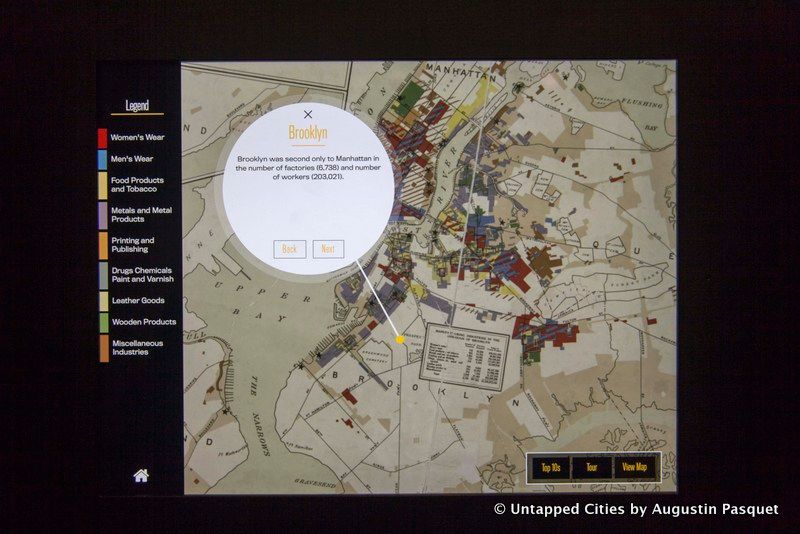
In the World City gallery, there are touch screens, also designed by Local Projects, attached to many of the display cases that provide additional information into the topic. This map, created by the Merchants’ Association of New York in 1922 utilizing 1919 Census data shows the diversity of manufacturing industries in New York City in this time period. What’s important to note, says curator Sarah Henry, is New York City’s market share of some of these industries versus the rest of the country. Women’s clothing brought in over $866 million a year, producing over 71% of the country’s production in that category, for example, highlighting how important many of these manufacturing industries were to the city’s growth.
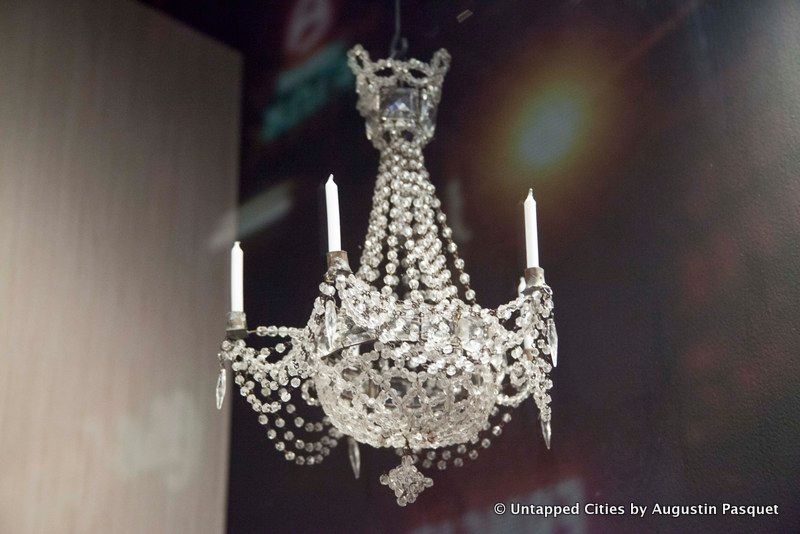
You know the famous opening scene in the film Breakfast and Tiffany’s, with Audrey Hepburn as Holly Golightly, wearing the oversized sunglasses, eating her croissant and looking into the windows at Tiffany’s on Fifth Avenue. There’s a chandelier hanging in the window in that scene, and it’s now in the exhibit.

A bath towel from the Continental Baths, a notorious gay bathhouse underneath the Ansonia Hotel, is one of many artifacts that speak to the nightlife art scene, and gay culture that existed in New York City in the era before AIDS – showing that despite difficult economic times, the city’s creative spirit was abounding. Another artifact here is a Studio 54 guest list, which includes names like Ringo Starr.

Not to miss in New York At its Core is the Future City Lab, which brings the first two historical galleries into the unknown future. The main attraction is a curved digital display that contains the “largest collection of digital data of the city anywhere,” says Henry. For those that want to go under the hood, there’s a separate room where visitors can look into the data data sets, which will be kept up to date. More than a museum, this is a tool to help plan and predict the future.
Side tables enable visitors to look into specific subjects: “Making a Living, “Housing a Growing City,” “Living Together,” “Living with Nature,” and “Getting Around” with built in design programs so you can redesign streets or built your own housing complex. Your final design project is saved and displayed on another screen in the lab, where you can actually insert yourself into the scene.
There’s so much to see at New York At its Core and among other highlights we didn’t have space to include: a circumcision kit, historical currency, medallion from the Erie Canal, a medical cabinet, objects from the lost Seneca Village in Central Park, a ticker tape machine and tools used to build the Brooklyn Bridge. Leave yourself enough time to really take in the themes of the exhibition – money, density, diversity, and creativity.
Read more from our curator walkthrough of New York At its Core. Learn more about the exhibit and see upcoming special events on the MCNY website. While you’re at the museum, check out Mastering the Metropolis: New York and Zoning, Gay Gotham, In the South Bronx with photography by Mel Rosenthal, and Timescapes.
Subscribe to our newsletter